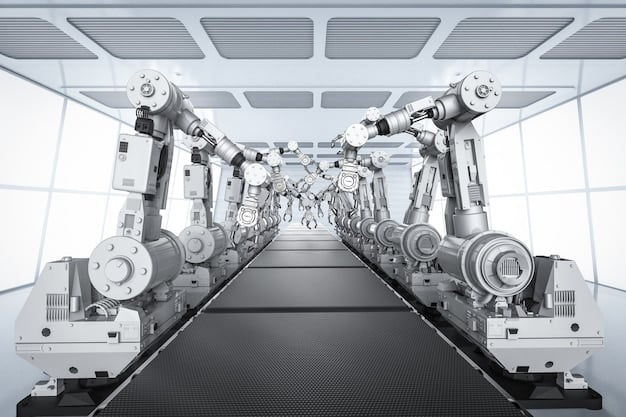Automation’s Impact: Analyzing the US Job Market Shift

Understanding the Impact of Automation on the US Job Market involves examining how technological advancements are reshaping employment opportunities, necessitating workforce adaptation, and driving economic changes across various sectors in the United States.
The rise of automation is transforming industries across the globe, and the US job market is no exception. **Understanding the Impact of Automation on the US Job Market** is crucial for workers, businesses, and policymakers to navigate the changes and prepare for the future of work.
Automation and the US Job Market: An Overview
Automation, driven by advancements in artificial intelligence (AI), robotics, and machine learning, is rapidly changing the landscape of the US job market. This technological revolution presents both opportunities and challenges, influencing job creation, job displacement, and the skills required for future employment.
Understanding the nuances of this impact is essential for informed decision-making and proactive strategies to mitigate potential negative consequences while harnessing the benefits of increased productivity and innovation.

The Rise of Automation Technologies
Several key technologies are driving the current wave of automation:
- Robotics: Robots are increasingly capable of performing physical tasks in manufacturing, logistics, and even service industries.
- Artificial Intelligence (AI): AI is being used to automate cognitive tasks such as data analysis, customer service, and decision-making.
- Machine Learning: Machine learning algorithms are enabling systems to learn from data and improve their performance over time without explicit programming.
- Cloud Computing: Cloud platforms provide the infrastructure and resources needed to deploy and scale automation solutions.
These technologies are converging to create powerful automation capabilities that can transform how work is done across various sectors.
Job Displacement and Creation: A Shifting Landscape
One of the primary concerns surrounding automation is its potential to displace workers from their jobs. While some jobs are undoubtedly at risk, automation also creates new opportunities and changes the nature of existing roles.
The net effect on employment is a complex and ongoing debate, with varying predictions about the long-term impact.
Sectors at Risk of Job Displacement
Certain sectors are more vulnerable to job displacement due to automation:
- Manufacturing: Repetitive tasks in manufacturing can be easily automated using robots and AI.
- Transportation: Self-driving vehicles have the potential to disrupt the transportation industry, affecting truck drivers, taxi drivers, and delivery personnel.
- Customer Service: AI-powered chatbots and virtual assistants are automating customer service interactions.
- Data Entry: Automated data processing systems are replacing manual data entry tasks.
Workers in these sectors may need to acquire new skills and consider career transitions to adapt to the changing job market.

The Skills Gap: Preparing for the Future of Work
As automation transforms the job market, the skills required for employment are also evolving. The demand for technical skills, such as programming, data analysis, and AI development, is growing rapidly.
However, soft skills, such as critical thinking, problem-solving, and communication, are also becoming increasingly important.
Bridging the Skills Gap
To address the skills gap, various initiatives are needed:
- Education and Training: Investing in education and training programs that focus on emerging technologies and in-demand skills.
- Lifelong Learning: Encouraging workers to engage in lifelong learning and skills development to remain relevant in the changing job market.
- Collaboration: Fostering collaboration between businesses, educational institutions, and government agencies to align training programs with industry needs.
- Reskilling and Upskilling: Providing reskilling and upskilling opportunities for workers in industries facing job displacement.
By addressing the skills gap, the US can ensure that its workforce is prepared for the future of work and can benefit from the opportunities created by automation.
Economic Impact: Productivity and Growth
Automation has the potential to drive significant economic growth by increasing productivity, improving efficiency, and reducing costs. By automating repetitive and mundane tasks, businesses can free up human workers to focus on more creative and strategic activities.
This can lead to increased innovation, improved product quality, and enhanced customer satisfaction.
Potential Economic Benefits
Some of the potential economic benefits of automation include:
- Increased Productivity: Automation can significantly increase productivity by enabling machines to work faster and more efficiently than humans.
- Reduced Costs: Automation can reduce labor costs, minimize errors, and optimize resource utilization.
- Enhanced Innovation: Automation can free up human workers to focus on more creative and innovative activities.
- Improved Competitiveness: Automation can help businesses become more competitive by improving efficiency and reducing costs.
To fully realize these economic benefits, it is important to address the potential social and labor market challenges associated with automation.
Policy Implications: Navigating the Transition
As automation transforms the US job market, policymakers have a crucial role to play in navigating the transition and mitigating potential negative consequences. This includes investing in education and training programs, providing support for displaced workers, and ensuring that the benefits of automation are shared broadly.
It also involves considering the ethical implications of AI and automation, such as bias, privacy, and security.
Policy Recommendations
Some policy recommendations to address the impact of automation include:
- Investing in Education and Training: Increasing funding for education and training programs that focus on STEM fields and emerging technologies.
- Providing Support for Displaced Workers: Offering unemployment benefits, job search assistance, and reskilling opportunities for workers who have lost their jobs due to automation.
- Promoting Inclusive Growth: Implementing policies that ensure that the benefits of automation are shared broadly, such as a progressive tax system and a strong safety net.
- Addressing Ethical Concerns: Developing ethical guidelines and regulations for AI and automation to address issues such as bias, privacy, and security.
By implementing thoughtful and proactive policies, the US can harness the benefits of automation while mitigating the potential risks.
The Role of Government, Business, and Education
Effectively managing the impact of automation requires a collaborative effort from government, business, and educational institutions. Government can set the policy framework and invest in education and training. Businesses can drive innovation and implement automation responsibly.
Educational institutions can prepare students and workers with the skills they need to succeed in the automated economy.
Collaborative Strategies
Examples of collaborative strategies include:
- Public-Private Partnerships: Collaborating on education and training programs that are aligned with industry needs.
- Industry-Led Initiatives: Developing industry-led initiatives to promote responsible adoption of AI and automation.
- Workforce Development Boards: Engaging workforce development boards to identify skill gaps and develop training programs.
By working together, government, business, and education can ensure that the US workforce is prepared for the challenges and opportunities of automation.
| Key Point | Brief Description |
|---|---|
| 🤖 Job Displacement | Automation threatens jobs in sectors like manufacturing and transportation. |
| 🚀 Job Creation | Automation creates new jobs in areas like AI development and data analysis. |
| 🎓 Skills Gap | There’s a growing need for skilled workers in technical and soft skills. |
| 💰 Economic Impact | Automation boosts productivity and economic growth. |
Frequently Asked Questions
▼
Jobs involving repetitive tasks, such as data entry, manufacturing, and transportation, are most susceptible to automation. These roles can be easily replicated by robots and AI, leading to job displacement.
▼
Workers can prepare by developing new skills, focusing on lifelong learning, and exploring career transitions to fields less susceptible to automation. Embracing new technologies will be essential for long-term career stability.
▼
Automation will create new jobs in areas like AI development, data analysis, robotics maintenance, and cloud computing. There will also be demand for roles that require creativity, critical thinking, and emotional intelligence.
▼
Government should invest in education and training programs, provide support for displaced workers, and ensure that the benefits of automation are shared broadly. Policies addressing ethical concerns related to AI are also crucial.
▼
Automation can boost economic growth by increasing productivity, reducing costs, and fostering innovation. By automating repetitive tasks, businesses can optimize resource use and free up human workers for more strategic activities.
Conclusion
Understanding the Impact of Automation on the US Job Market requires a comprehensive approach that addresses both the opportunities and challenges. By investing in education, supporting displaced workers, and implementing proactive policies, the US can navigate the transition and harness the benefits of automation for long-term economic growth and prosperity.